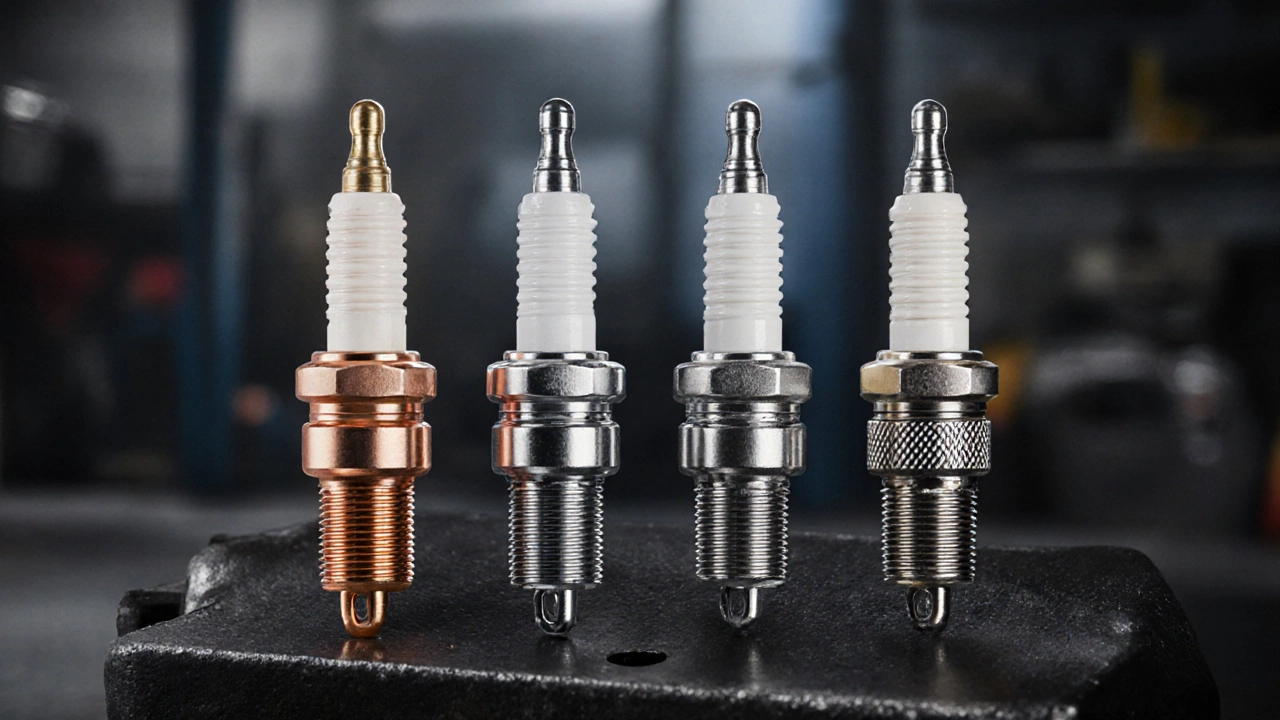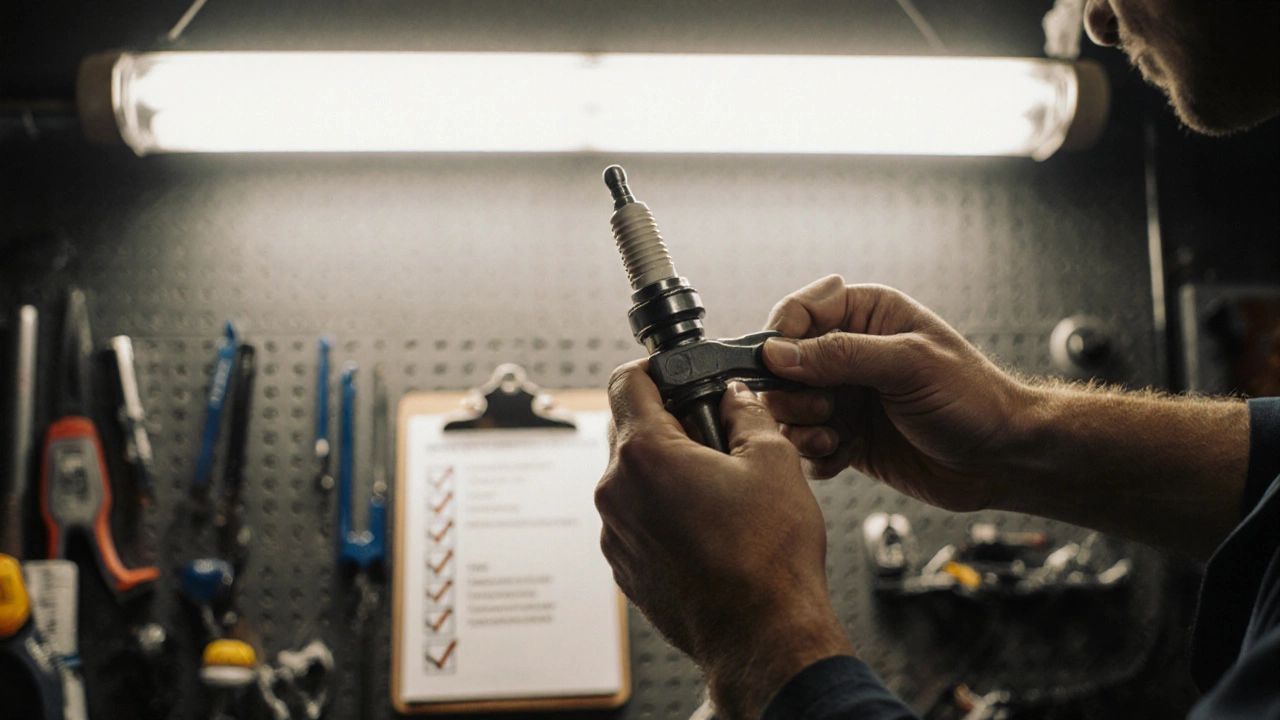Spark Plug Power Gain Calculator
Enter your details and click "Calculate Potential Power Gain" to see estimated horsepower improvements.
Spark Plug Performance Overview
Copper
Basic performance, low cost
Low GainPlatinum
Moderate improvement, longer life
Moderate GainIridium
Sharp spark, high performance
High GainLaser-Etched
Optimal for forced induction
Very High GainEver wondered if swapping out your stock plugs could actually push the needle on your dyno? The short answer is yes - but only under the right conditions. This guide breaks down how spark plugs affect power, which plugs really make a difference, and how to avoid common traps that leave you with a pricey part and no extra whine.
How Spark Plugs Influence Engine Power
At its core, a spark plug is a device that delivers an electric spark to ignite the air‑fuel mixture inside a combustion chamber. That spark starts the explosion that pushes the piston down, turning the crankshaft and ultimately creating spark plugs horsepower - the very power you feel on the road.
Three key factors tie a plug to performance:
- Spark intensity - a hotter, more focused spark can ignite the mixture faster, reducing ignition delay.
- Heat range - the plug’s ability to dissipate heat prevents pre‑ignition while staying hot enough for consistent sparks.
- Electrode design - material and shape affect durability and the voltage needed from the ignition system.
When these elements line up, the engine burns the mixture more completely, squeezing a few extra horsepower out of each cylinder.
Types of Spark Plugs and Their Performance Traits
Not all plugs are created equal. Below is a quick snapshot of the most common types and what they bring to the table.
| Type | Electrode Material | Heat Range | Typical Lifespan | Power‑Gain Potential | Price (US$) |
|---|---|---|---|---|---|
| Copper | Copper core, chrome tip | Hot | 15‑20k miles | Low - mainly for stock engines | 3‑5 |
| Platinum | Platinum tip (single or double) | Medium‑hot | 30‑45k miles | Moderate - helps high‑rev engines | 6‑9 |
| Iridium | Iridium tip (single or double) | Cool‑medium | 60‑100k miles | High - sharper spark, better for performance tunes | 12‑18 |
| Laser‑etched | Iridium tip with laser‑etched electrode | Cool‑medium | 70‑120k miles | Very high - optimal for forced‑induction setups | 20‑30 |
While copper plugs are cheap, they usually won’t give you a measurable boost unless the stock plug is severely worn. Platinum offers a modest improvement for engines that rev high. Iridium and laser‑etched plugs provide the sharpest spark, making the most difference when the engine’s timing is already optimized.

When Upgrading Spark Plugs Can Yield Horsepower
Even the best plug can’t magically add power to a badly tuned engine. Look for these scenarios where a plug swap actually translates into measurable gains:
- Aftermarket Tuning - If you’ve installed a performance chip or ECU flash that advances timing, a hotter, more conductive plug can keep up with the faster ignition demands.
- High‑Performance Engines - Naturally aspirated motors that operate near redline benefit from the quicker spark of iridium plugs, shaving a few tenths of a second off quarter‑mile times.
- Forced Induction - Turbo or supercharged engines run richer mixtures and higher cylinder pressures; a cooler‑range plug prevents pre‑ignition while delivering a strong spark.
- Old or Worn Stock Plugs - If your current plugs show electrode wear or carbon buildup, replacing them with fresh iridium plugs can restore lost power.
In each case, the power increase is typically in the 1‑5% range - enough to feel, but not enough to replace a full engine rebuild.
Choosing the Right Plug for Power Gains
Here’s a quick decision flow to match plug type to engine needs:
- Identify your engine’s rev range. If you regularly exceed 6,000rpm, aim for platinum or iridium.
- Check your current heat range. A too‑hot plug on a turbo engine leads to knock; choose a cooler‑rated iridium.
- Consider the ignition voltage. Older coils may struggle with high‑performance iridium; ensure your coil can supply the required voltage.
- Factor in budget and lifespan. If you swap plugs every 30k miles, platinum is a cost‑effective sweet spot.
After picking the type, verify the exact part number for your make and model - even a one‑millimeter difference in thread length can affect heat transfer.

Common Pitfalls and Myths
Strong opinions abound on forums, but some ideas simply don’t hold up:
- “All iridium plugs add 10hp.” - The gain depends on engine condition, tuning, and whether the stock plug was already optimal.
- “You can’t go too hot.” - Over‑hot plugs cause pre‑ignition, which can actually destroy an engine before you notice a power dip.
- “More voltage always means more power.” - Too much voltage can erode electrodes faster and increase wear.
- “DIY installation is risky.” - As long as you follow torque specs (usually 13‑15lb‑ft) and gap the electrode correctly (check your vehicle’s manual), the swap is straightforward.
Remember, the biggest power boost often comes from a holistic approach: proper fueling, timing, and exhaust flow, with the spark plug playing a supporting role.
Quick Checklist for a Power‑Focused Plug Upgrade
- Confirm engine’s rev range and whether it’s naturally aspirated or forced‑induction.
- Identify the stock plug’s heat range and compare with manufacturer recommendations.
- Select a plug material (platinum for moderate revs, iridium for high‑performance or turbo applications).
- Check ignition coil voltage compatibility.
- Purchase the exact part number for your vehicle.
- Set the gap to the spec (usually 0.030‑0.045in).
- Torque the plug to the correct value (13‑15lb‑ft for most cars).
- After installation, run a diagnostics scan to confirm ignition timing.
Follow these steps and you’ll maximize the chance that your new plugs translate into real‑world horsepower.
Frequently Asked Questions
Will any spark plug increase my car’s horsepower?
Not necessarily. A plug can only add power if the engine’s ignition timing, fuel delivery, and airflow are already optimized. In a stock engine with a well‑matched plug, the gain is often negligible.
How much horsepower can I realistically expect from an iridium plug?
Most tests show a 1‑3% increase, which translates to about 5‑15hp on a 300‑hp engine. The exact figure depends on the engine’s rev range and whether other performance tweaks are present.
Do I need to re‑gap the plugs after installing new ones?
Yes. Even if the plug comes pre‑gapped, variations in handling can shift the gap. Use a feeler gauge and set it to the spec listed in your vehicle’s service manual.
Can a hotter spark plug cause knocking?
A plug that’s too hot can retain excess heat, raising cylinder temperature and increasing the risk of pre‑ignition or knock, especially in turbocharged engines.
Is it worth spending more on laser‑etched plugs?
Laser‑etched plugs deliver the sharpest spark and the longest life, making them ideal for high‑output, forced‑induction builds. For a daily driver, platinum or standard iridium is usually sufficient.






